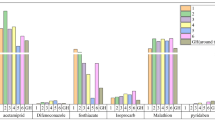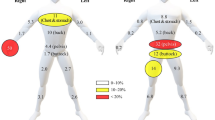Abstract
We examined the significance of meteorology and postspray volatilization of methamidophos (an organophosphorus insecticide) in assessing potential inhalation risk to children in an agricultural community. We combined fluxes from sources and dispersion modeling with a range of possible local meteorology to create output to study the variability in potential community exposure as a result of changing temperature, wind speeds and wind directions. This work is based on an aerial spray drift study where air sampling measurements of methamidophos were made before, during and after a spray event were used to examine acute inhalation risk for children living in an Eastern Washington State community in close proximity (between 15 and 200 m) to sprayed potato fields. We compared the measured average air concentrations of methamidophos in the community to a “no observed adverse effect level” for subchronic inhalation to characterize acute and subchronic inhalation risks. The baseline estimates of inhalation exposure were below Environment Protection Agency's (EPA) level of concern based on a target margin of exposure of 300. As meteorological conditions during and after spraying influence the amount of material moving into areas where children reside we used historical meteorological data to drive model simulations that predicted likely air residue concentrations under different wind and temperature conditions. We also added variability to the decay constant and initial emission fluxes to create a 2-D simulation of estimated air concentrations in the community near the fields. This work provides a methodological framework for the assessment of air concentrations of pesticides from agricultural sprays in the absence of extended measurements, although including variability from meteorological conditions. The deterministic as well as the probabilistic risk analyses in this study indicated that postspray volatilization in the specific spray situation analyzed (methamidophos applied on potato fields in Eastern Washington) did not pose acute or subchronic risks as defined by the EPA. However, this study did not consider any pathway of exposure other than inhalation (e.g. diet, dermal, etc.) and the risk assessment should be evaluated in that context.
This is a preview of subscription content, access via your institution
Access options
Subscribe to this journal
Receive 6 print issues and online access
$259.00 per year
only $43.17 per issue
Buy this article
- Purchase on Springer Link
- Instant access to full article PDF
Prices may be subject to local taxes which are calculated during checkout






Similar content being viewed by others
Abbreviations
- AI:
-
active ingredient
- EPA:
-
Environment Protection Agency
- FDM:
-
fugitive dust model
- FQPA:
-
Food Quality Protection Act
- HQ:
-
hazard quotient
- LOC:
-
level of concern
- MOE:
-
margin of exposure
- NOAEL:
-
no observed adverse effect level
- OP:
-
organophosphorus
- RED:
-
registration eligibility decision
- RfD:
-
reference dose
- VP:
-
vapor pressure
References
Antonious G.F., and Snyder J.C. Residues and half-lives of acephate, methamidophos, and pirimiphos — methyl in leaves and fruit of greenhouse-grown tomatoes. Bull Environ Contam Toxicol 1994: 52: 141–148.
Bedos C., Cellier P., Calvert R., Barruso E., and Gabrielle B. Mass transfer of pesticides into the atmosphere by volatilization from soils and plants: overview. Agronomie 2002: 22: 21–33.
Camann D.E., Geno P.W., Harding H.J., Giardio N.J., Bond A.E., Lewis R.G., and Akland G.G. A pilot study of pesticides in indoor air in relation to agricultural applications. In: Seppanen O. (Ed.). Indoor Air 1993: Proceedings of the Sixth International Conference on Indoor Air Quality and Climate, Helsinki, Finland, 4–8 July, Vol. 2, Helsinki 1993.
Conover W.J. Practical Nonparametric Statistics. John Wiley, New York, 1980, 493p.
Dansereau C., and Perez M. Poisons on the wind- Community Air Monitoring for Chlorpyrifos in Yakima Valley. A Report by Farmworker Pesticide Project & Pesticide Action Network North Americ; Dec 2006, http://www.panna.org/docsdrift/POWExSumEng.pdf.
Elgethun K. Global positioning system (GPS) tracking to characterize children's exposure to pesticides, PhD dissertation. University of Washington, 2004.
Harnly M., McLaughlin R., Bradman A., Anderson M., and Guneir R. Correlating the use of OPs with outdoor air concentrations: a particular concern for children. Environ Health Perspect 2005: 113 (9): 1184–1189.
Hatzilazarou S., Charizopoulos M., Papadopoulo-Mourkidou E., and Economou A.S. Pesticide dissipation in the greenhouse environment during hydroponic cultivation of Gerbera. Proceedings of XXVI IHC — Horticulture, Human Well-Being and Life Quality 2004.
Lee S., McLaughlin R., Harnley M., Gunier R., and Kreutzer R. Community exposures to airborne agricultural pesticides in California — ranking of inhalation risks. Environ Health Perspect 2002: 110: 1175–1184.
Lowenherz C., Fenske R.A., Simcox N.J., Bellamy G., and Kalman D.A. Biological monitoring of organophosphorus pesticide exposure among children of agricultural workers in central Washington State. Environ Health Perspect 1997: 105: 1344–1353.
Pasquill F., and Smith F.B. Atmospheric Diffusion — Study of the Dispersion of Windborne Material from Industrial and Other Sources, 3rd edn. Ellis Horwood Series in Environmental Science 1983.
Ramaprasad J., Tsai M.Y., Elgethun K., Hebert V.R., Felsot A., Yost M.G., and Fenske R.A. The Washington Aerial Spray Drift Study: assessment of off-target organophosphorus insecticide atmospheric movement by plant surface volatilization. Atmos Environ 2004: 38: 5703–5713.
Taylor A.W., and Spencer W.F. Volatilization and Vapor Transport Processes Pesticides in the Soil Environment: Processes, Impacts and Modeling, SSSA Book Series, Vol. 2 Soil Science Society of America, Madison, WI, 1990, pp. 213–269.
Tsai M.Y., Elgethun K., Ramaprasad J., Yost M.G., Felsot A.S., Hebert V.R., and Fenske R.A. The Washington Aerial Spray Drift Study: modeling pesticide spray drift from an aerial application. Atmos Environ 2005: 39: 6194–6203.
Umsworth J.B., Wauchope R.D., Klein A.W., Dorn E., Zech B., Yeh S.M., et al. International Union of Pure and Applied Chemistry (IUPAC) pesticide report 41. Significance of the long range transport of pesticides in the atmosphere. Pure Appl Chem 1999: 71: 1359–1383.
U.S. EPA. Pesticide Environmental Fate One Line Summary: methamidophos. U.S. EPA Environmental Fate and Effects Division, Washington, DC, 1989.
U.S. EPA. 1994. Emission Factor Documentation for AP-42, Section 922 Pesticide Applications. EPA Contract No. 68-D2-0159 Midwest Research Institute, Kansas City, MO, September URL: http://www.epa.gov/ttn/chief/ap42/ch09/bgdocs/b9s02-2.pdf.
U.S. EPA. 2000. Methamidophos Revised Toxicology Chapter for RED, URL:http://www.epa.gov/oppsrrd1/op/methamidophos.htm.
USEPA. Child Specific Exposure Factors Handbook. National Center for Environmental Assessment, Washington, DC, 2002a. EPA/600/P-00/002B. Available from National Information Service, Springfield, VA; PB2003-101678 http://cfpub.epa.gov/ncea/cfm/recordisplay.cfm?deid=55145.
USEPA. Interim Reregistration Eligibility Decision for Methamidophos, Case No 0043 2002b: http://www.epa.gov/oppsrrd1/op/methamidophos.htm.
USDA NASS (U. S. Department of Agriculture National Agricultural Statistics Service). 2004. Agricultural Chemical Usage 2003 Field Crops Summary p. 71 http://usda.mannlib.cornell.edu/MannUsda/viewDocumentInfo.do?documentID=1001.
Van den Berg F., Kubiek R., Benjey W., Majewski M., Yates S., Reeves G., et al. Emission of pesticides in the air. Water Air Soil Pollut 1999: 115: 195–218.
Weppner S., Elgethun K., Lu C., Hebert V., Yost M.G., and Fenske R.A. The Washington Aerial Spray Drift Study: children's exposure to methamidophos in an agricultural community following fixed-wing aircraft applications. J Expo Anal Environ Epidemiol 2006: 16: 387–396.
Whang J.M., Schomburg C.J., Glotfelty D.E., and Taylor A.W. Volatilization of tomofos, chlorpyrifos and atrazine from conventional and no-till surface soils in the field. J Environ Qual 1993: 22: 173–180.
Woodrow J.E., and Seiber J.N. Correlation techniques for estimating pesticide volatilization flux and downwind concentrations. Environ Sci Technol 1997: 31: 523–529.
Acknowledgements
This study was supported by the US EPA (RD-83170901-0), the National Institute of Environmental Health Sciences (2P01ES09601) Child Health Centers Program and the Agricultural Centers Program of the National Institute for Occupational Safety and Health (5450OH07544). We thank Vince Hebert (Washington State University) for invaluable help with data collection.
Author information
Authors and Affiliations
Corresponding author
Rights and permissions
About this article
Cite this article
Ramaprasad, J., Tsai, MY., Fenske, R. et al. Children's inhalation exposure to methamidophos from sprayed potato fields in Washington State: Exploring the use of probabilistic modeling of meteorological data in exposure assessment. J Expo Sci Environ Epidemiol 19, 613–623 (2009). https://doi.org/10.1038/jes.2008.66
Received:
Accepted:
Published:
Issue Date:
DOI: https://doi.org/10.1038/jes.2008.66
Keywords
This article is cited by
-
Examining the role of wind in human illness due to pesticide drift in Washington state, 2000–2015
Environmental Health (2021)
-
Acetylcholinesterase activity and time after a peak pesticide-use period among Ecuadorian children
International Archives of Occupational and Environmental Health (2018)
-
Seasonal and occupational trends of five organophosphate pesticides in house dust
Journal of Exposure Science & Environmental Epidemiology (2017)
-
How does exposure to pesticides vary in space and time for residents living near to treated orchards?
Environmental Science and Pollution Research (2017)



